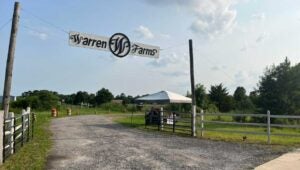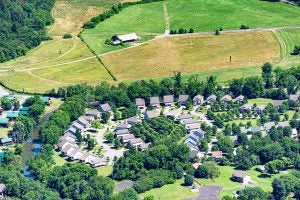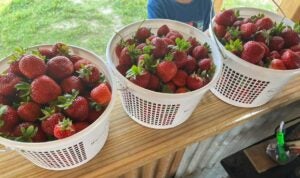Conservation advocates work on the front lines in regions where high agricultural values and high development collide.
Real estate agent Woody Warren believes he could get as much as $10 million by selling the Chesapeake, Virginia, dairy farm his grandfather started in the early 20th century after the Prohibition era.
“But I wouldn’t sleep for the rest of my life, because my dad and my grandpa are going to be in my head. So, there’s no chance of that happening,” he said.
Many in the Chesapeake area are skeptical that Warren will hold out with that much money at stake. The southeast Virginia region, which includes the military cities of Virginia Beach and Norfolk, has nearly 1.2 million residents, a booming increase of about 20 percent over the past two decades.
The expanding population means a shift in development southward toward the North Carolina border, where motor access has improved thanks to the Virginia 168 toll road, which bisects Warren’s family farm and offers an express route to North Carolina’s Outer Banks tourist area.
These flat lower coastal plains sit close to sea level and are crisscrossed with numerous creeks, drainages, and canals. They are prime farmland but also relatively easy building sites for single-family housing. Shopping centers and subdivisions have turned some of the area’s most bountiful sections into pockets of blacktop, stoplights, and signage.
Each year, the congestion of the region becomes more difficult to escape, with elected officials carefully weighing the value of open spaces and developers eager to exploit zoning loopholes to bring dense housing communities — often criticized as low-quality, cookie-cutter construction — to the landscape.
“Some guys that I know around town that are like, ‘Within five years, he’ll sell that place. He’s gonna take that money,’” Warren said. “These are guys that obviously don’t know me that well.”

The farmland crisis playing out in southeast Virginia is echoing across high land-value regions around the U.S., with the coasts hit particularly hard, while rapid-growth regions such as Colorado also feel the pinch. Farmers and ranchers playing a high-stakes game of risk amid increasing machinery costs, fluctuating commodity prices, and unpredictable weather patterns can hardly be blamed for taking a lump-sum payout and heading into retirement on stable footing.
Still, advocates say that society can’t afford for everyone to sell off their land. Communities need some producers to resist the temptation from deep-pocketed developers, even when the common-sense question is: Why would they hold out?
According to the U.S. Department of Agriculture, the nation has about 893 million acres of farmland, down 22 million acres from 10 years prior. It’s a statistic that experts and stakeholders say cannot be ignored, especially as the average age of American producers hovers near 60 years old and relatively few young people have the interest or capital to take their place.
“Most of the time, just like our situation, it’s a multi-generational farming family,” said Warren, now in his 40s. “But my generation — my brother, my sister, myself — we’re not farming every day. So now we’re left deciding what to do with almost 500 acres of farmland that was an active, productive dairy farm.”
They could sell, but they are resolved not to. And there is a larger movement to incentivize landowners to keep their farms in production for reasons well beyond their wallets.
Next door to Chesapeake, Virginia Beach has had a farmland protection program in place since the mid-1990s, facilitating agricultural conservation easements, which is considered one of the most effective tools used to protect farmland.
While the federal government is the largest funder of farmland protection in the country, roughly 100 municipalities also have a farmland protection program at the city or county level. There are even 27 states that fund farmland protection programs, with New Jersey being the largest in that category.
Most of these programs emerged in the 1980s and ’90s and historically target places where there are high agricultural values and high development.
“It’s a classic example of hyper-development and trying to create an incentive for farmland owners to not sell out to development in one form or another,” said Ben Kurtzman, American Farmland Trust’s Director of Land Protection Projects. He has spent nearly 20 years with AFT and oversees the acquisition of agricultural conservation easements, among other roles.
Kurtzman said that despite the financial incentives his organization and others can facilitate, it’s impossible to close the gap between what a developer can offer and what a preservation program can help with. The motivation to keep farmland pristine has to be more deeply rooted, often as a sacred familial responsibility to counterbalance the temptation of a payout.
“The land and an appreciation for that land compels folks to want to keep going,” Kurtzman explained. “Some people point to a need, the idea of no farms, no food, and that we need to have farms in our communities. It’s a pretty altruistic mission.
“Other people would say, ‘Well, what else would I do if I didn’t farm?’ That’s a common response,” he added.
The rise of local farm-to-table movements and the public’s desire to connect more directly with their food and with growers are helping residents rally around nearby farms and initiate protection programs at the government level. It’s a drastic change from the 1970s and ’80s, when many farms, especially larger ones, were looked at as “polluters” and “part of the problem” in many communities.
Today, there is a renaissance of interest in farming, and growers are seen in a more favorable (and even romanticized) light.

Those involved with farmland preservation said it’s most often the medium-sized farms — the ones that are a few hundred acres — that are enrolling in these programs. Larger operations can aggregate and be profitable through scale and technology, while properties under 40 acres are finding success in niche markets and through innovative production methods.
Yet that middle ground, the one commonly considered the “traditional family farm,” often ends up being the most vulnerable to development.
“The decision [to sell] is almost always centered around finances. They’re either in debt or unable to transition that farm to the next generation,” Kurtzman said. “They are taking care of themselves, taking care of their retirement, taking care of their kids. They’re taking care of their debt, frankly. This isn’t happening because they’re tired of farming. It’s because the developer comes in and offers them relief from some very real problems.”
Conservation programs do their best to balance farmers’ financial needs. New Jersey’s Farmland Preservation Program, for example, restricts the amount of future non-agricultural activity that can exist on an operation while infusing it with capital to expand existing operations, eliminate or reduce debt load, or further a growers’ estate or retirement planning.
On the opposite coast, the California Farmland Conservancy Program has two key project types: agricultural conservation easements that limit conversion of land to non-farm uses, and land improvement grants that give financial backing for land protected by a conservation easement.
American Farmland Trust has recently championed a national Buy-Protect-Sell+ farmland program, which is a land transition model that can help farmers without heirs transfer property to a new generation of producers, including young and beginning farmers or historically marginalized or disadvantaged farmers. Coastal Virginia is one of the nonprofit’s highest-priority sites for the program.
In Virginia Beach, the Agricultural Reserve Program is a smaller-scale incentive program — financed with interest-free discounted bonds known as Treasury STRIPS — that assesses land values and creates conservation easements in perpetuity. The STRIPS are held for 25 years, with semi-annual interest paid on the purchase price and a balloon payment of the principal at the end.
“It’s an incentive to keep ag land in agriculture,” said Julia Hillegass, coordinator for the Agricultural Reserve Program. “It’s market-based. Right now, interest is pretty good, so we’re very popular. Twelve months or so ago, interest was less than 2 percent, so we were not that popular. It was a very hard sell. Now it’s between 4 and 4.3 percent. So that’s a good thing.”
The program requires a minimum of 10 acres to be enrolled, and income from the land has to be derived from active farming. While many traditional corn, soybeans, and wheat producers are involved, there is also a sizable number of fruit and vegetable farms.
The first program participants came on board in 1997, so early adopters have been receiving their final payments over the past year.
“We’ve seen the program come to fruition,” she said. “We’ve had some of those final payments, and people were very happy.”
Her program is vital because of the high number of farmers who are leaving the industry, with no one to replenish their numbers. She understands that more than most.
“Many of the growers now who are stepping away either don’t have heirs at all or don’t have heirs who want to farm,” said Hillegass, whose family owns Bright’s Produce & Christmas Tree Farm. “I’m an only child, and I’m not going to physically farm. I might rent it to a farmer, but I’m not physically on the tractor. So, the future of our small farm, I’m not sure what that’s going to be.”
Indeed, this isn’t just an on-farm issue. This is a recognition in rural and fringe communities that productive farms and healthy soil are assets worth protecting and that people need to be planning for a future with food.
The urgency with this issue is that decades-old policies to shelter rural areas from large-scale development are under increasing scrutiny.
One of those policies was the imaginary “Green Line” in Virginia Beach, developed in the wake of a city population boom during the late 1970s. This line was a marking to ward off new subdivisions and major retail centers in the southern part of the city. Yet recent years have seen companies such as Walmart and Amazon encroach on the line like never before.
“The north end of Virginia Beach is pretty much fully built out, and a lot of the other nearby cities are built out as well,” said Hillegass, who has been in her role protecting farmland for the past six years. “So, the only place there is to go in Virginia Beach is south.”
The same goes for Chesapeake, where lands to the north are fully developed and those to the south are becoming more congested. But throughout the area, there’s only so far south one can go before buildable land turns into swampland and federal nature preserves.
Warren grew up hearing stories about how his grandfather moved from North Carolina and bought a farm in a remote section of Chesapeake known as Great Bridge. It was viable for decades, beginning as a dairy before later incorporating Brangus cattle, a hybrid beef breed derived from crossing Angus and Brahman stock.
Then in the late 1990s, as the family was expanding the operation with more pastures and fencing, the toll road was constructed and cut the farm in half.
There was now no way to move cows between pastures, and more traffic meant more liability if animals escaped onto the road. Walmart wanted to build a new shopping center in the area, and Warren says the retailer offered the family upwards of $7 million to sell the land in 1996.
Even though the division of the property impacted the farm’s profitability, the Warrens refused.
Twenty years later, when Warren’s father passed away, the family had to revisit a strategy of how to move forward. The cows were less of a business than they used to be, and the family decided to sell them all. Neither Warren nor his siblings intended to farm full time. But they wanted the farm to remain.
Warren had an idea. “I told my mom, ‘Look, Dad put the strawberries in the ’90s up front for all the people that would travel to the Outer Banks. We should do that.’ ” A new direction for the farm had materialized.

Today, Warren Farms is a thriving strawberry operation, having wrapped up its third production season on a few of its acres. Warren’s goals are to grow food that’ll benefit the community, educate people about what they eat, and keep the land in agricultural production.
He hopes to someday incorporate agritourism opportunities, an aspect of agri-centric preservation that is also gaining ground in Virginia Beach, where a surprising number of young beginning farmers have shown interest in specialty functions and low-impact food processing facilities. Warren’s plans include converting one of the older farm structures into a restaurant and finding ways to keep the active acreage as an oasis from the roughly 1,500 homes that will be built around him in the next decade.
“What my job has to be is turning it into something that’s so productive that it allows my family to all work together, if they want to, to build out the land with new ideas,” he said. “And that fresh new generation, they will be rewarded with a job that pays them well to run something that’s good for the community.”
Ryan Tipps is the founder and managing editor of AGDAILY. He has covered farming since 2011, and his writing has been honored by state- and national-level agricultural organizations.



